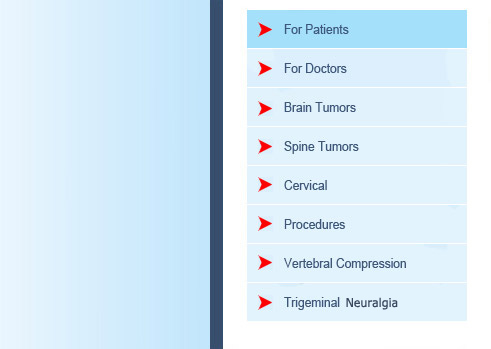|


|

Trigeminal Neuralgia
What is Trigeminal neuralgia?
Trigeminal neuralgia (TN) is a chronic pain condition that
affects the trigeminal or fifth cranial nerve, one of the
largest nerves in the head. The disorder causes extreme,
sporadic, and sudden burning or shock-like pain on the face
that can last anywhere from a few seconds to as long as two
minutes per episode. These attacks can occur in quick
succession, and are usually described as manifeting around the
area of the lower face and jaw. The pain is usually limited to
one side of the face. The intensity of pain can be physically
and mentally incapacitating, but it is not a life-threatening
disorder. The presumed cause of TN is a blood vessel pressing
on the trigeminal nerve in the head as it exits the brainstem,
where it branches out to the forehead, cheek, and lower jaw.
TN may be part of the normal aging process but in some cases
it may be associated with other disorders, such as multiple
sclerosis or disorders characterized by damage to the myelin
sheath that covers certain nerves.
What are the symptoms of Trigeminal Neuralgia?
TN is characterized by a sudden, severe, electric shock-like,
stabbing pain that is typically felt on one side of the jaw or
cheek. Some patients say the first attack comes out of
nowhere; others report that they first felt it after a car
accident, blow to the face, or other trauma. Whatever its
origin, it is described by some as the most agonizing pain
known to humankind. The slightest breeze can trigger TN, or
simply day-to-day activities such as brushing teeth, smiling,
or applying make-up. The pain can occur on both sides of the
face, although typically not at the same time. The attacks of
pain, which generally last several seconds and may repeat in
quick succession, coming and going throughout the day. These
episodes may last for days, weeks, or months at a time and
then disappear for months or years. In the days before an
episode begins, some patients report experiencing a tingling
or numbing sensation or a somewhat constant and aching pain.
Once the episode is over, the pain often leaves patients with
uncontrollable facial twitching, which is why the disorder is
also known as tic douloureux.
The pain of trigeminal neuralgia is defined as either classic
or atypical (also known as “TN-2″). With classic pain, there
are definite periods of remission. The pain is intensely
sharp, throbbing and shock-like, and usually triggered by
touching an area of the skin, or by specific activities.
Atypical pain is often present as a constant, burning
sensation affecting a more diffuse area of the face. With
atypical trigeminal neuralgia, there may not be a remission
period, and symptoms are usually more difficult to treat.
How is Trigeminal Neuralgia diagnosed?
Trigeminal neuralgia can be difficult to diagnose due to the
absence of definitive diagnostic tests as well as the wide
variety of conditions that can trigger pain. The diagnosis of
TN is essentially clinical; a physician must be well-trained
to recognize key words in patients’ descriptions of symptoms.
Above all, your doctor should be able to differentiate TN pain
from the many other types of facial pain. Finding the cause of
the pain is very important, because treatment differs
depending on the type of pain. Other types of facial pains
that could lead to an incorrect diagnosis include atypical
facial pain, herpetic neuralgia, atypical odontalgias, cluster
headaches, and other types of entrapments of the trigeminal
nerve by post-tramatic conditions or tumors. Some patients may
have tumors, and the well-known blood vessel compressing the
trigeminal nerve along its course from the ganglion to the
brainstem.
One of the tools Dr. Berti uses in diagnosing TN is magnetic
resonance imaging (MRI). The MRI may detect whether a tumor or
multiple sclerosis is irritating the trigeminal nerve;
however, unless either of these is the cause, imaging of the
brain will seldom reveal the precise reason the nerve is being
irritated. The blood vessel adjacent to the nerve root is
difficult to see even on a high quality MRI. Physicians
diagnose patients based on patients’ descriptions of pain and
symptoms, as well as a battery of tests that rule out other
sources of pain, including multiple sclerosis. Thus, it is
immensely important to find a physician who has extensive
experience in treating TN, due to the difficulty in diagnosing
it.
How is Trigeminal Neuralgia treated?
Although it is not a life-threatening disorder, TN can be
debilitating and cause people to miss multiple days of work as
well as important moments in their lives. Dr. Berti strives to
take care of his patients with a multi-modality approach.
Patients suffering from TN have several options available to
them, including medication, surgery, complementary or
alternative therapies, and stereotactic radiosurgery. Dr.
Berti will explore all treatment options with his patients
based on their comfort level, health, age, and comorbidities
to create a treatment plan that works best for them.
Some of the more common medications prescribed for TN include
anticonvulsants and tricyclic antidepressants, or medications
such as Carbamazepine, Baclofen, Phenytoin, and Oxcarbazepin.
If the medications become ineffective, or if the patient
experiences serious side effects, he or she may be eligible
for surgery. Surgery can be beneficial to some, and may be
performed on an outpatient basis or may be more complex and
require hospitalization. Dr. Berti may recommend
miscrovascular decompression (MVD), a surgical procedure that
will relieve the compression of the trigeminal nerve. MVD of
the trigeminal nerve is performed via a retromastoid approach,
where the trigeminal nerve is separated from the vessel that
is compressing it with a sponge, usually at the entry root
zone or the area close to the brain stem where there are less
or no oligodendrical cells that cover the nerve. This area is
where the brain may interpret any sensations as electrical
shocks. Microvascular decompression has an approximately 80%
succeess rate at two years after surgery
A patient with TN who has difficulty tolerating medications,
or who has pain despite these medications, is an excellent
candidate for stereotactic radiosurgery such as Gamma Knife or
CyberKnife radiosurgery. Stereotactic radiosurgery computer
imaging is used to direct highly focused beams of radiation at
the site where the trigeminal nerve exits the brainstem. This
causes the slow formation of a lesion on the nerve that
disrupts the transmission of pain signals to the brain. While
patients usually leave the hospital the same day or the next
day following treatment, pain relief from this procedure may
take several months to manifest. Dr. Berti has had excellent
results with CyberKnife radiosurgery, offering an 80% success
rate with the control of facial pain. Patients who have opted
for CyberKnife treatment have either stopped taking
medications or their medications have become more effective as
they take them. Patients also have the option of alternative
or complementary approaches such as biofeedback, acupuncture,
and electrical stimulation of the nerves.
“Studies have shown that: Excellent pain relief was initially
experienced by 64 out of 95 patients (67%). The median time to
pain relief was 14 days (range, 0.3-180 d). Posttreatment
numbness occurred in 45 (47%) of the patients treated. Using
higher radiation doses and treating longer segments of the
nerve led to both better pain relief and a higher incidence of
hypesthesia. The presence of posttreatment numbness was
predictive of better pain relief. The overall rate of
complications was 18%. At the mean follow-up time of 2 years,
47 of the 95 patients (50%) had sustained pain relief, all of
whom were completely off pain medications.”
|
|
|
 |



